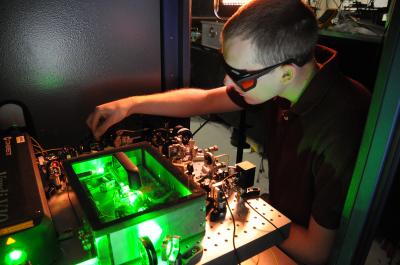Physicists at the National Institute of Standards and Technology (NIST) have combined laser technologies to produce microwave signals of high purity and stability when compared to traditional electronic sources. In addition to improving the stability of signals, the device could offer improved resolution in communications, radar, and navigation devices and specific types of atomic clocks.
 Matt Kirchner, a University of Colorado graduate student, fine-tunes an ultra-stable microwave generator that he helps operate at NIST
Matt Kirchner, a University of Colorado graduate student, fine-tunes an ultra-stable microwave generator that he helps operate at NIST
The low-noise device from NIST proves useful in equipment based on ultra-fast lasers for accurate measurement of optical frequencies or colors and in optical frequency combs, which are referred to as "gears" and used for experimental advanced atomic clocks. These atomic clocks convert optical pulses to microwave frequencies of lower wavelengths that can be electronically counted.
NIST scientists had to manufactur two copies of the device to measure the system's performance precisely since the novel low-noise system was so efficient. Each system utilizes a continuous-wave laser to deliver a stable and continual signal as its frequency matches the high stability of an optical cavity with a high "quality factor". This laser is linked to a frequency comb to transfer high stability to microwaves.
The transfer process lowers random fluctuations significantly in the valleys and peaks or electromagnetic wave’s phase over time scales of one second or below. This process produces a signal that is purer and stronger at the desired frequency.
The base microwave signal is 1 GHz or 1 billion cycles per second, which is useful to generate optical frequency combs and the signal can either be a harmonic or a multiple of that frequency. The laser is capable of illuminating a photodiode that generates a 1 GHz signal or any multiple of 15 GHz.